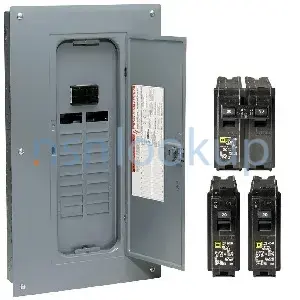Circuit Breaker
Item Name Code (INC) 00136
 |
A device with means other than fuses for automatically opening the circuit in which it is installed when the current varies from the predetermined value for which the device is set. May include provisions for manual operation. At least one set of contacts must be in series with the actuating element(s). A combination of semiconductor and passive devices may be used in lieu of contacts. For automatically operated items in which the actuating (tripping) element and contacts are not in series, see RELAY (as modified). For items which are operated both manually and automatically but the actuating elements and contact are not in series, see RELAY-SWITCH. Excludes CIRCUIT BREAKER BOX and magneto "breaker" assemblies. See also SWITCH (as modified); and CONTROLLER.
 Additional Information for Circuit Breaker
Additional Information for Circuit Breaker
Circuit breakers are devices used to protect electrical circuits from overloads, short circuits, and other electrical faults. They are an essential component in electrical systems as they help prevent damage to equipment and reduce the risk of electrical fires.
In the supply class Circuit Breakers, which belongs to the supply group Electrical And Electronic Equipment Components, circuit breakers are specifically designed to interrupt the flow of electrical current when a fault is detected. They are typically installed in electrical distribution panels or switchboards and are available in various types and sizes to accommodate different voltage and current ratings.
Circuit breakers work by automatically opening the circuit when an abnormal current flow is detected. This can be caused by an overload, where the current exceeds the rated capacity of the circuit, or a short circuit, where a low-resistance path is created between the conductors. When a fault occurs, the circuit breaker trips and interrupts the current flow, preventing further damage to the circuit and connected devices.
Some common types of circuit breakers include:
1. Thermal Circuit Breakers: These circuit breakers use a bimetallic strip that bends when exposed to excessive heat, causing the contacts to open and interrupt the current flow.
2. Magnetic Circuit Breakers: These circuit breakers use a solenoid coil that generates a magnetic field. When a high current flows through the coil, the magnetic field pulls a plunger, causing the contacts to open.
3. Electronic Circuit Breakers: These circuit breakers use electronic components, such as transistors or integrated circuits, to monitor the current flow and trip the circuit breaker when necessary.
4. Residual Current Circuit Breakers (RCCBs): These circuit breakers are designed to detect and protect against ground faults, which occur when current leaks to the ground. RCCBs monitor the imbalance between the current flowing in the live and neutral conductors and trip the circuit if a fault is detected.
Circuit breakers are crucial for the safe and reliable operation of electrical systems. They provide protection against electrical faults and help ensure the continuity of power supply. When selecting a circuit breaker, it is important to consider factors such as the rated voltage and current, the type of fault protection required, and the specific application in which it will be used.